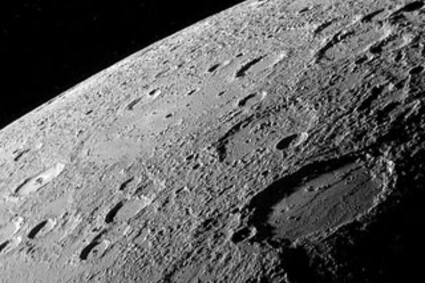Stars over Sisters
Last updated 6/28/2011 at Noon
During the month of July the elusive planet Mercury will give us the rare chance for a sighting in the evening sky. Stargazers can take advantage of Sisters' clear, dark skies and high altitude to catch a glimpse of this small inner planet just after sunset.
Our unusually good viewing conditions for Mercury come just as we are receiving new data and photos from the spacecraft MESSENGER about this little-understood planet. Late last month the probe took the first high-quality pictures of the surface (see photo) and made measurements of the chemical composition that will help us learn more about this planet.
To see Mercury right after sunset look to the west for a star-like object approximately 10 degrees above the horizon in the twilight. Greatest elongation is on July 20, which means the angular distance between Mercury and the sun will be at its greatest on that date, giving us the best viewing conditions.
Those interested in constellations can get a good look at Draco during the month of July. Rooted in the Latin word for dragon, Draco is among the earliest of the constellations to be defined. Although the constellation can be seen year-round, this month the head of the beast is nearly overhead as darkness falls. Four thousand years ago the star Thuban in Draco was the North Star, but due to the precession of Earth's axis of rotation, today the North Star is Polaris. As precession continues, Thuban will once again be the North Star in the year 2100.
In Greek mythology, the constellation was a dragon called Laden, chosen by Hera to guard the golden apples of immortality. Draco's snake-like appearance is defined by 13 relatively bright stars that seem to coil around the constellation of Ursa Minor (better known as the Little Dipper) in the northern sky.
Lunar watchers will note the month kicks off with a new moon on July 1. During this phase the moon is between the sun and the earth making the surface appear dark from our perspective. On July 8 the first quarter occurs; at that point the moon is at a 90-degree angle with respect to the earth and sun. The full moon will be on July 15, when the moon will be on the opposite side of the Earth to the sun. Last quarter will occur on July 22. The month ends with another new moon on July 30.
These are only a few of the celestial highlights going on this month. If you want to learn more about the night sky, the next Sisters Astronomy Club meeting is on July 7, 7 p.m., at Sisters Park & Recreation District's Coffield Center. The next Stars over Sisters star watch is on Friday, July 29, at 9 p.m. at Coffield Center.

















Reader Comments(0)